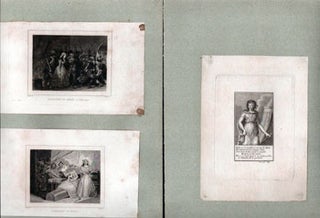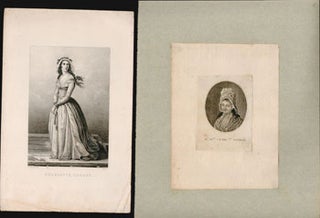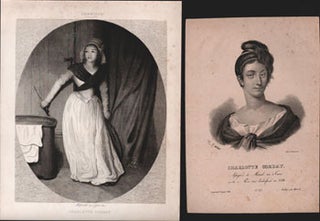A Collection of Portraits of Charlotte Cordray. (1768-1793) Original graphic works from the 18th & 19th Centuries
France: 18th and 19th Centuries. 17 engravings and lithographs. Various sizes, largest is 44.5 x 31 cm. sheet size. Most of these not reproduced on the internet... Library of Congress text: Charlotte Corday, born Marie-Anne-Charlotte Corday d'Armont was born in Normandy on July 27, 1768 and was executed on July 17, 1793 in Paris. Corday is buried at Chapelle Expiatoire in the 8th arrondissement in Paris. Interestingly, this cemetery is dedicated to Marie Antoinette and her husband King Louis XVI, although they are buried elsewhere. .....She is largely remembered as the assassin of French Revolutionary leader, Jean-Paul Marat while he rested in his bath at home. She was born into a poor but noble family in the Auvergne-Rhône-Alps region in the south east of France, but she was being educated in Caens which is in Normandy in the North. She began going to political meetings there and became inspired by the ideas of the Revolution, and in particular the Girondin faction. The Girondins were a more moderate faction that was in favor of a Constitutional government...... They represented the educated provincial middle class of France (lawyers, merchants etc.) and they stood against the "Paris mob" who tended to be in line with the opposing political party, the Jacobins. Corday felt that the Jacobins were too radical and she wanted to save the Revolution by eliminating their most popular leader, Jean-Paul Marat. With this in mind, she traveled to Paris and insisted on seeing Marat, promising either to divulge the names of traitors of the Revolution or to plead for the lives of her Girondin acquaintances (historical records disagree on her ostensible reason for meeting with Marat)......Regardless of how she managed to gain access to Marat, she was allowed in while he was bathing (he suffered from a skin condition) and she plunged a knife directly into his heart causing his instant death. She was arrested immediately and soon found guilty and guillotined. All accounts attest to a brave and dignified death. The assassination of Marat was memorialized in the famous painting, Death of Marat, by Jacques-Louis David which hangs in the Louvre. Initially her violent act scandalized Paris and some felt it reflected poorly on women revolutionaries. Many women distanced themselves from her for this reason. Her intention to weaken the power of the Jacobins was a failure. Marat gained martyr status overnight and the Girondins as a faction were demonized and eliminated during the subsequent Jacobin-led Terror. However, she lives on in France's popular memory through numerous works of art, poetry, plays and literature. She was given the moniker the "angel of assassination" by French writer Alphonse de Lamartine who dedicated part of his series, Histoire des Girondins (1847) to her...... Regardless of her political views, Charlotte Corday changed the way women were viewed during the Revolution in terms of personal agency and having the courage of one's convictions......Provenance: Sophie Renard, Chateau-Thierry. 02400 Brasles, France. Item #16-5159
Price: $1,250.00





